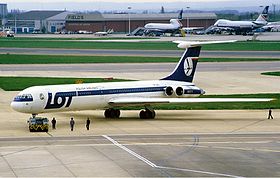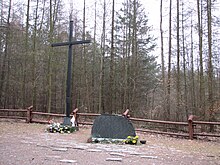LOT flight 5055
| LOT flight 5055 | |
|---|---|
|
The plane involved in the accident in April 1987 at London Heathrow Airport |
|
| Accident summary | |
| Accident type | Crash after engine damage and fire |
| place |
Warsaw , Poland Coordinates: 52 ° 6 ′ 48.2 ″ N , 21 ° 2 ′ 39.1 ″ E |
| date | May 9, 1987 |
| Fatalities | 183 |
| Survivors | 0 |
| Injured | 0 |
| Aircraft | |
| Aircraft type | Ilyushin Il-62M |
| operator | LOT |
| Mark | SP-LBG |
| Departure airport |
Warsaw-Okęcie , Poland |
| Destination airport |
John F. Kennedy International Airport , United States |
| Passengers | 172 |
| crew | 11 |
| Lists of aviation accidents | |
An Ilyushin Il-62 the Polish airline LOT Polish Airlines crashed on May 9, 1987, the LOT Flight 5055 in the Kabaty Woods in Warsaw during the Notlandeanfluges to the airport Okęcie by an engine damage. All 183 inmates died; thus it was the most momentous aircraft accident of 1987, in Polish history and of the Ilyushin Il-62 aircraft type. In Poland, the accident is commonly referred to as the Kabaty Forest Disaster ( Polish katastrofa w Lesie Kabackim ).
Flight and airplane
Flight LO 5055 was a transatlantic flight operated by the Polish airline LOT from Warsaw's Okęcie Airport (WAW / EPWA) to New York's John F. Kennedy International Airport (JFK / KJFK).
The aircraft involved in the accident was a four-engine Ilyushin Il-62M built in 1983 with the aircraft registration SP-LBG, which was christened " Tadeusz Kościuszko ". The machine had completed 6971 flight hours and 1752 landings by May 9, 1987. After the plane returned from Chicago in the evening on May 8, 1987 , it was subjected to a six-hour inspection .
The following morning, the aircraft took off from runway 33 at 10:17 a.m. The crew consisted of eleven people: the flight captain Zygmunt Pawlaczyk, the co-pilot, radio operator , navigator , flight engineer and five flight attendants; in addition, due to the flight engineer’s ongoing training, a flight engineer instructor was added to the crew. The pilots took up the north-westerly course on Graudenz as planned and began the climb in order to reach the agreed flight level 310 (31,000 feet, 9449 m). However, since flight level (FL) 180 (5486 m) could not be reached up to the radio beacon "TMN" at Płońsk , the flight control prompted the crew to maintain the reduced altitude at FL 160 (4877 m) until Graudenz, as the area between the FL 170 and 180 were temporarily reserved for maneuvers by military aircraft .
accident
At 10:31 a.m. after flying under the military reserved area, the crew was prompted to perform an accelerated climb, so the flight engineer set all four engines to take-off thrust. At 10:41 a.m., when Warlubie was overflown, the crew noticed popping noises and vibrations, then they reported the failure and fire of the left-hand engines No. 1 and 2 as well as a rapidly falling cabin pressure . Therefore, the flight captain Pawlaczyk decided to return to Warsaw immediately at a reduced altitude. The crew found that the elevator was defective, but the trim rudder remained functional and the machine could only be controlled in this way. Three minutes later, the fire alarm system indicated that the fire in the engine nacelles had been extinguished by the automatic fire extinguishing system.
In order to achieve the permissible landing weight , the aircraft let off kerosene en route to Warsaw , which was only partially successful due to the partially defective valves and with only one functioning power generator. When the crew realized that they could not maintain the altitude with only two active engines, they asked for permission to land at the nearby Modlin military airfield . Approval, including the transmission of the runway parameters, was given quickly at 10:54 a.m., but air traffic control had no information on the current weather situation (especially wind direction) at the airport. The crew then decided to risk the longer approach to the well-known and well-equipped home airport Okęcie. Because of the northwest wind in Okęcie, the air traffic control offered an emergency landing in the southeast direction (33), which would mean an additional orbit around the airport south of Warsaw. After the indicator lights in the pilot's cockpit reported another outbreak of fire in the rear of the aircraft, the faster but riskier landing with the tail wind (runway 15) was considered as an alternative. However, the crew missed the chance to steer the aircraft on the appropriate approach route, so they stayed with direction 33.
At around 11:00 a.m., the flight captain ordered the preparatory measures for the emergency landing. He was then informed by the chief flight attendant that the flight attendant Hanna Chęcińska could not be found. The crew suspected that this had been sucked out of the aircraft tail by the negative pressure when decompression occurred and a door was presumably lost.
The actual approach to landing began at 11:08 a.m. The landing gear could not be extended and 32 t of kerosene remained in the fuel tanks. Since the fire had meanwhile spread to the passenger cabin and was clearly visible to the observers on the ground, the decision was made to use the shortest possible approach route from the chosen direction. On the sharp left turn over Piaseczno the machine became uncontrollable. Less than six kilometers from the threshold, the aircraft collided at 11:12:13 a.m. at a speed of 470 km / h with the tree tops in the Kabaty Forest on the southern edge of Warsaw's Ursynów district , then broke apart over a 370 m long area and went up in flames.
The last recorded words from the crew's radio communications were:
“Dobranoc! Do widzenia! Cześć! Giniemy! "
"Good night! Goodbye! Bye! We're going to die! "
Victim
All inmates perished on impact or immediately afterwards. These included eleven crew members and five other LOT employees among the 172 passengers. Seventeen passengers were US citizens only and 155 Polish citizens, but 21 of these were registered abroad (possibly dual citizenship).
Corpses or body parts of 121 of the 183 victims could be identified. The method of DNA analysis was not yet available to pathologists at that time. The unidentified remains were buried in a collective grave in the Wólka Cemetery in Warsaw. With regard to the missing flight attendant Chęcińska, it was assumed that she died in the rear of the aircraft as a result of decompression and that her remains were not identified after the crash.
Cause of accident
A high-level committee chaired by Deputy Prime Minister Zbigniew Szałajda was set up to investigate the cause of the accident . Since the flight recorders were found quickly and the course of the accident was basically known, the focus was on engine no. 2 (left inside) as the source of the damage. The examination of the aircraft debris revealed that the low-pressure turbine had been torn out of the Solowjow-D-30-KU - turbofan engine and that the rear section of the shaft was completely missing. A large part of the missing components could be found in the area around Warlubie after an extensive search operation for which 700 soldiers were specially delegated.
Contrary to all assurances, the Soviet side did not provide any manufacturer documentation for the engines, so the investigation committee worked on the basis of the maintenance documents, the identical, undamaged engines and the calculated parameters. Inside the hollow high pressure shaft of the D-30-KU, the low pressure shaft was mounted coaxially on roller bearings . The dismantling of the shafts of the damaged engine showed that only 13 rollers were installed in a roller bearing instead of 26 rollers. The manufacturer tried to compensate for the reduced number of rollers by piercing the outer ring of the bearing in three places to allow the lubricant to circulate. Nevertheless, due to the friction, flat spots have formed on the drilled holes on one side of the rollers, and the axis of the internal low-pressure shaft has shifted by 1.3 mm. This led to increased friction against the high-pressure wave (outside) and subsequently to material fatigue of the low-pressure wave under the effect of the increased temperature during the climb phase in flight 5055. The wave broke apart. Decoupled from the load normally applied by the fan and the compressor, the low-pressure turbine accelerated to supercritical rotational speed and its first disc fell apart into three roughly equal parts. One part pierced the engine nacelle upwards and caused no further damage, while the second part hit the turbine of engine 1 (far left) and set it on fire. This fire was extinguished three minutes after the damage. The third part of the broken pane pierced the rear of the aircraft and destroyed the pushrods of the elevator, several electrical cables and caused the air pressure drop in the cabin and the fire in the rear part of the hold, which initially went undetected. The remainder of the low pressure turbine of engine # 2 and the associated aft section of the low pressure shaft fell out of the engine.
It was never possible to clarify without a doubt the reasons why the roller bearing was only half equipped and provided with openings. In the planned economy , the loss of the required components during production could play a role, as these were strictly regulated in terms of quantity and time.
The following were identified as secondary causes of the accident:
- the susceptibility to failure of the height control mechanism,
- the insufficient passive fire protection of the aircraft tail in the area between the engines,
- the use of easily inflammable substances in the hold.
The presumption of a collision with a military aircraft, which was already expressed by the crew during the incident, is considered to be refuted.
The committee of inquiry ruled that the behavior of the crew was appropriate and not partly responsible for the accident.
On November 25, 1987, the Deputy Prime Ministers of Poland and the USSR signed an agreement on the conclusions and technical recommendations based on the accident investigation.
Commemoration
On May 10 and 11, 1987, state mourning was ordered in the city of Warsaw and in the Warsaw Voivodeship . On May 23, the publicly staged memorial service for the crew members and other injured LOT employees took place in the Powązki cemetery , with Captain Pawlaczyk being buried in the family grave in the Catholic cemetery and 14 other airline employees in the municipal cemetery.
In the immediate vicinity of the crash site, a forest aisle was called Aleja Załogi Samolotu "Kościuszko" (avenue of the crew of the aircraft "Kościuszko") and further away a street after the flight captain ulica Zygmunta Pawlaczyka . A memorial at the crash site commemorates the victims.
See also
Web links
- Aircraft accident data and report in the Aviation Safety Network (English)
- Documentation about the accident (Polish)
- 05/09/1987 - last flight of "Kościuszko" - recording of radio correspondence. (Polish)
literature
- Aleksander Grobicki: Niezwykłe katastrofy . Wydawnictwa "Alfa", Warszawa 1990, ISBN 83-7001-256-6 .
- Jarosław Reszka: Cześć, giniemy . Wydawnictwo Polskiej Agencji Prasowej, Warszawa 2001, ISBN 83-911242-3-1 .
- Marek Sarjusz-Wolski: Cisza po życiu . Państwowe Wydawnictwo Iskry, Warszawa 1989, ISBN 83-207-1200-9 .



